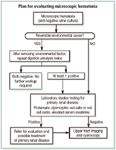Article
A 4-step approach to asymptomatic microscopic hematuria
Once you discover microscopic hematuria, typically the next step is evaluation with a careful history and physical exam, then specific laboratory tests, and cystoscopic and radiologic studies.

Key Points
Contributor
Patrick J. Culligan, MD,
Clinical Associate Professor of Obstetrics and Gynecology, UMDNJ Medical School, Newark, NJ; Director, Division of Urogynecology and Reconstructive Pelvic Surgery, Atlantic Health System, Morristown and Summit, NJ.
Microscopic hematuria is common and can be caused by a wide variety of medical conditions. The strict definition of hematuria is 3 or more RBCs per high-power field in at least 2 of 3 properly collected urinalysis specimens.1 But there is no threshold of microscopic hematuria under which significant disease can be ruled out.2 In this article, I lay out a 4-point plan for evaluating women with asymptomatic microscopic hematuria, based on the latest data in the medical literature.


Detecting hematuria
Widespread use of dipstick testing has greatly increased recognition of microscopic hematuria. Simple dipstick testing in the office is 91% to 100% sensitive and 65% to 99% specific for detection of more than 3 RBCs per high-power field.8 False-positive dipstick testing can occur in the presence of povidone-iodine, myoglobin, or free hemoglobin. Other environmental factors that commonly lead to positive results include menses, recent sexual activity or other urogenital trauma, strenuous exercise, and any repetitive jolting (such as horseback riding or aerobics classes).

Newsletter
Stay current with the latest urology news and practice-changing insights — sign up now for the essential updates every urologist needs.
















